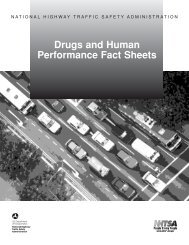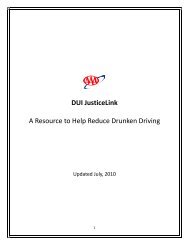2007 National Roadside Survey of Alcohol and Drug Use by Drivers
2007 National Roadside Survey of Alcohol and Drug Use by Drivers
2007 National Roadside Survey of Alcohol and Drug Use by Drivers
You also want an ePaper? Increase the reach of your titles
YUMPU automatically turns print PDFs into web optimized ePapers that Google loves.
<strong>2007</strong> <strong>National</strong> <strong>Roadside</strong> <strong>Survey</strong> <strong>of</strong> <strong>Alcohol</strong> <strong>and</strong> <strong>Drug</strong> <strong>Use</strong> <strong>by</strong> <strong>Drivers</strong>: <strong>Drug</strong> Results<strong>Drug</strong>s: Oral Fluid Results <strong>and</strong> Agreement with Self-Reported <strong>Drug</strong> <strong>Use</strong>Table 46 compares the results <strong>of</strong> the oral fluid analyses with responses to the self-reported druguse questionnaire. This questionnaire was administered to all drivers who provided an oral fluidsample, <strong>and</strong> was completed while the oral fluid device was collecting the saliva.The cross tabulation results <strong>of</strong> self-reported drug use (in the past 24 hours, past 2 days, pastmonth, past year, over a year, <strong>and</strong> never) <strong>and</strong> oral fluid analysis results (<strong>by</strong> drug category)revealed interesting findings. Note that this table only reports on drivers who were drug-positive.Agreement between reported past 24-hour use <strong>and</strong> drug-positive analysis results for thenighttime driving sample was greatest (highest percentage) among antidepressants, coughsuppressants, <strong>and</strong> pain killers.The lowest correspondence (lowest percentages) was found for amphetamines <strong>and</strong> barbiturates.Interestingly, approximately one-quarter <strong>of</strong> marijuana-positive nighttime drivers admitted tomarijuana use in the previous 24 hours; this increased to over one-third when combined withinthe past two days. A smaller proportion (7.5% <strong>and</strong> 5.8% respectively) admitted to recent use <strong>of</strong>cocaine.Among nighttime drivers who tested positive for antidepressants, the majority (66.4%) indicatedthey in fact used the substance in the past 24 hours. Thus, in this example, agreement betweenself-reports <strong>and</strong> oral fluid analysis results are fairly high. However, when we examineamphetamines (typically viewed as a recreational or illegal drug), agreement between self-report<strong>and</strong> a positive test analysis is low. Here, about 72 percent <strong>of</strong> nighttime positive drivers indicatedthey “never” had used the substance yet the drug analysis revealed a positive result. In someinstances this may be related to a reluctance to disclose; however, in other instances a driver maynot have been aware that the substance they were taking contained the drug being reported (forexample, some drivers may not be aware that some diet pills contain amphetamines). Similarresults were obtained for nighttime drivers providing blood samples. A table reflecting thoseresults appears in Appendix A.59




